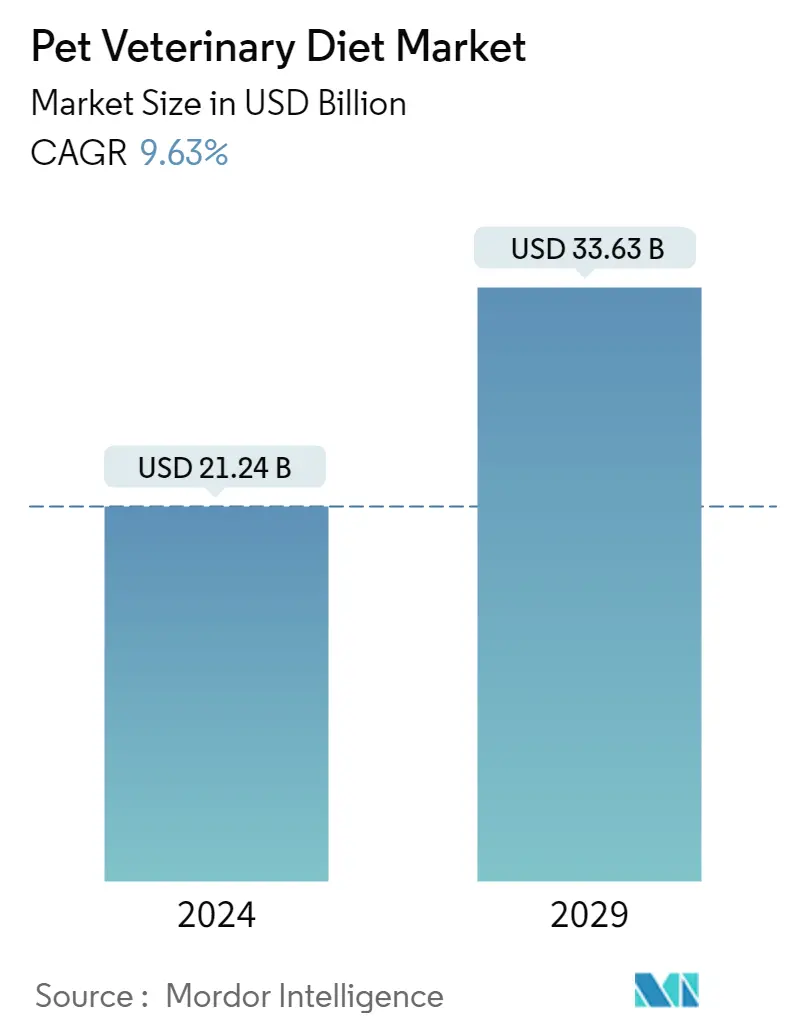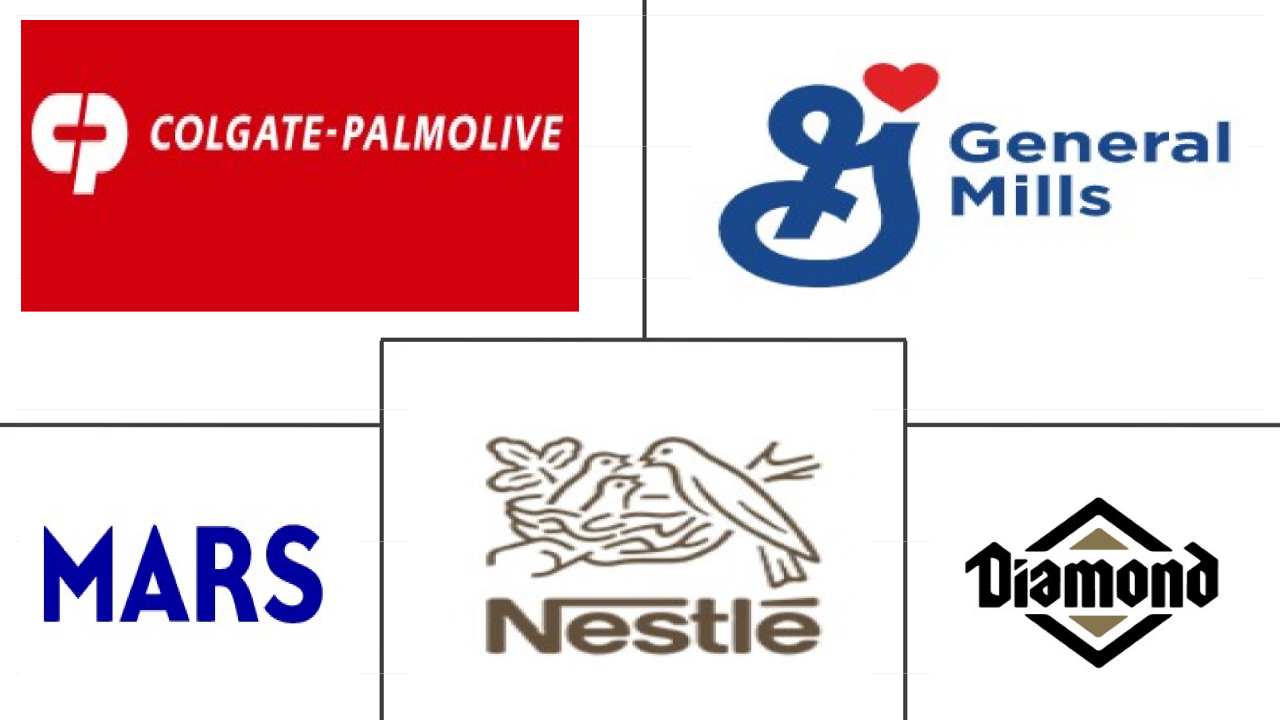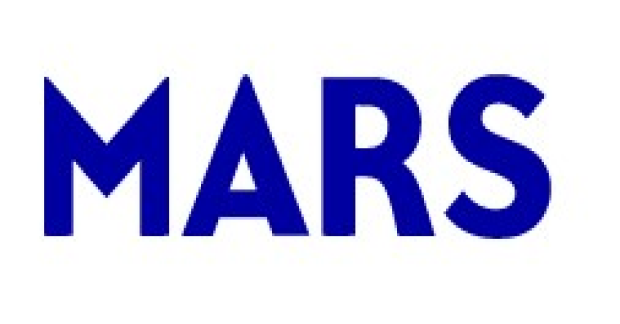Market Size of pet veterinary diet Industry

|
|
Study Period | 2017 - 2029 |
|
|
Market Size (2024) | USD 21.24 Billion |
|
|
Market Size (2029) | USD 33.63 Billion |
|
|
Largest Share by Pets | Dogs |
|
|
CAGR (2024 - 2029) | 9.63 % |
|
|
Largest Share by Region | North America |
Major Players |
||

|
||
|
*Disclaimer: Major Players sorted in no particular order |
Pet Veterinary Diet Market Analysis
The Pet Veterinary Diet Market size is estimated at USD 21.24 billion in 2024, and is expected to reach USD 33.63 billion by 2029, growing at a CAGR of 9.63% during the forecast period (2024-2029).
21.24 Billion
Market Size in 2024 (USD)
33.63 Billion
Market Size in 2029 (USD)
11.23 %
CAGR (2017-2023)
9.63 %
CAGR (2024-2029)
Largest Market by Sub Product
22.23 %
value share, Digestive Sensitivity, 2022
The rising prevalence of digestive issues among pets is driving the segment, as these products contain digestive enzymes that effectively support the gut health of pets.
Largest Market by Region
47.91 %
value share, North America, 2022
The share of the region has increased due to its higher pet ownership rates, increasing concerns about pet health, and rising demand for preventive healthcare measures.
Fastest-growing Market by Sub Product
10.97 %
Projected CAGR, Oral Care Diets, 2023-2029
The increasing prevalence of oral and dental issues among pets and the significance of these diets in promoting oral and dental health are driving the segment’s growth.
Fastest-growing Market by Region
14.18 %
Projected CAGR, South America, 2023-2029
The regional market is growing due to the rising pet ownership rates and increasing consumer spending on custom-made veterinary diets based on specific pet health requirements.
Leading Market Player
15.67 %
market share, Mars Incorporated, 2022

Mars, Incorporated is the market leader due to its heavy investments toward launching products that are focused on targeting multiple pet health issues, such as digestive and urinary tract diseases.
Dogs dominated the global pet veterinary diets market due to their increasing susceptibility to various diseases
- Global pet ownership rates are steadily rising as the global economy is rapidly growing, driven by increasing urbanization and industrial rates. The attitude toward pets has been evolving, particularly in developing countries over the years. As a result, the global veterinary diet market reached USD 17.64 billion in 2022, which increased by 74.4% between 2017 and 2022. This growth is driven by the growing trend of pet humanization.
- The dog segment held a major share of the global pet veterinary diet market, with a value of USD 9.11 billion in 2022. This dominance is attributed to the presence of a large population of dogs and their increased susceptibility to various diseases due to their lifestyle and genetics. Furthermore, the larger size of dogs necessitates a higher demand for veterinary diets to meet their specific nutritional needs.
- The cats segment is emerging as one of the fastest-growing segments in the global pet veterinary diet market, with a projected CAGR of 7.5% during the forecast period. This is owing to the significant increase in the cat population as a result of the growing popularity of cats as pets due to their low maintenance requirements and cost-effectiveness compared to other pets.
- Other pets also have significant requirements for veterinary diets to prevent various potential health problems. However, the population of other pets is low due to legal and environmental restrictions. As a result, the other pets' veterinary diet market reached a value of USD 2.76 billion in 2022.
- The increasing awareness among pet owners and the growing population of pets are estimated to drive the global pet veterinary diet market during the forecast period.
Growing pet humanization and increasing pet owners focus on their pet health driving the pet veterinary diets market
- In the global veterinary diets market, North America held the largest market share, accounting for 47.9% of the market in 2022. In the region, the United States is the largest market, valued at USD 7.54 billion in the same year. The large market share of the United States can be attributed to the prevalent usage of specialized pet diets and the growing trend of pet humanization, where pets are regarded as family members and receive specialized care.
- Europe has the second-largest share of the global pet veterinary diets market, with a value of USD 4.64 billion in 2022. The region's growth is highly driven by increasing awareness of pet owners on their pet health and well-being. Veterinary diets have gained significant importance across the region. Europe's pet veterinary diets market increased by 44.6% between 2017 and 2021, owing to the rising pet population in the region, which reached 324.4 million in 2022, increasing from 290.5 million in 2017.
- Asia-Pacific accounted for 17.6% of the market, valued at USD 3.10 billion in 2022. Asia-Pacific had a major share due to its pet population being 32.8% of the global pet population in the same period. The growing awareness about pet health concerns and pet humanization trend among pet owners in Asia-Pacific increased the pet veterinary diets market in the region by 40% between 2017 and 2021.
- South America is the fastest-growing region for the pet veterinary diets market, which is anticipated to record a CAGR of 14.2% during the forecast period. This can be attributed to the growing pet owner's focus on their pet health driven by the increasing pet humanization.
- The growing pet population and pet humanization globally are the factors anticipated to drive the market during the forecast period.
Pet Veterinary Diet Industry Segmentation
Diabetes, Digestive Sensitivity, Oral Care Diets, Renal, Urinary tract disease are covered as segments by Sub Product. Cats, Dogs are covered as segments by Pets. Convenience Stores, Online Channel, Specialty Stores, Supermarkets/Hypermarkets are covered as segments by Distribution Channel. Africa, Asia-Pacific, Europe, North America, South America are covered as segments by Region.
- Global pet ownership rates are steadily rising as the global economy is rapidly growing, driven by increasing urbanization and industrial rates. The attitude toward pets has been evolving, particularly in developing countries over the years. As a result, the global veterinary diet market reached USD 17.64 billion in 2022, which increased by 74.4% between 2017 and 2022. This growth is driven by the growing trend of pet humanization.
- The dog segment held a major share of the global pet veterinary diet market, with a value of USD 9.11 billion in 2022. This dominance is attributed to the presence of a large population of dogs and their increased susceptibility to various diseases due to their lifestyle and genetics. Furthermore, the larger size of dogs necessitates a higher demand for veterinary diets to meet their specific nutritional needs.
- The cats segment is emerging as one of the fastest-growing segments in the global pet veterinary diet market, with a projected CAGR of 7.5% during the forecast period. This is owing to the significant increase in the cat population as a result of the growing popularity of cats as pets due to their low maintenance requirements and cost-effectiveness compared to other pets.
- Other pets also have significant requirements for veterinary diets to prevent various potential health problems. However, the population of other pets is low due to legal and environmental restrictions. As a result, the other pets' veterinary diet market reached a value of USD 2.76 billion in 2022.
- The increasing awareness among pet owners and the growing population of pets are estimated to drive the global pet veterinary diet market during the forecast period.
| Sub Product | |
| Diabetes | |
| Digestive Sensitivity | |
| Oral Care Diets | |
| Renal | |
| Urinary tract disease | |
| Other Veterinary Diets |
| Pets | |
| Cats | |
| Dogs | |
| Other Pets |
| Distribution Channel | |
| Convenience Stores | |
| Online Channel | |
| Specialty Stores | |
| Supermarkets/Hypermarkets | |
| Other Channels |
| Region | |||||||||||||||
| |||||||||||||||
| |||||||||||||||
| |||||||||||||||
| |||||||||||||||
|
Pet Veterinary Diet Market Size Summary
The pet veterinary diet market is experiencing significant growth, driven by increasing global pet ownership and the evolving perception of pets as family members. This trend, particularly pronounced in developing countries, has led to a substantial rise in demand for specialized veterinary diets. The market is characterized by a strong focus on dog and cat segments, with dogs holding a major share due to their larger population and specific nutritional needs. Cats, however, are emerging as a rapidly growing segment, fueled by their rising popularity as low-maintenance pets. The market's expansion is further supported by the increasing awareness among pet owners regarding pet health and well-being, as well as the trend of pet humanization, which emphasizes the importance of providing high-quality nutrition to pets.
Regionally, North America leads the market, with the United States being the largest contributor, attributed to the widespread adoption of specialized pet diets and the pet humanization trend. Europe follows closely, driven by heightened awareness of pet health among owners. The Asia-Pacific region also holds a significant share, with a growing pet population and increasing health consciousness among pet owners. South America is noted as the fastest-growing region, reflecting a burgeoning focus on pet health. The market is fragmented, with major players like Colgate-Palmolive Company, General Mills Inc., Mars Incorporated, Nestle (Purina), and Schell & Kampeter Inc. dominating the landscape. The shift from offline to online purchasing of veterinary diets, particularly post-pandemic, is also shaping market dynamics, as consumers seek the convenience and variety offered by online platforms.
Pet Veterinary Diet Market Size - Table of Contents
-
1. MARKET SEGMENTATION (includes market size in Value in USD and Volume, Forecasts up to 2029 and analysis of growth prospects)
-
1.1 Sub Product
-
1.1.1 Diabetes
-
1.1.2 Digestive Sensitivity
-
1.1.3 Oral Care Diets
-
1.1.4 Renal
-
1.1.5 Urinary tract disease
-
1.1.6 Other Veterinary Diets
-
-
1.2 Pets
-
1.2.1 Cats
-
1.2.2 Dogs
-
1.2.3 Other Pets
-
-
1.3 Distribution Channel
-
1.3.1 Convenience Stores
-
1.3.2 Online Channel
-
1.3.3 Specialty Stores
-
1.3.4 Supermarkets/Hypermarkets
-
1.3.5 Other Channels
-
-
1.4 Region
-
1.4.1 Africa
-
1.4.1.1 By Country
-
1.4.1.1.1 South Africa
-
1.4.1.1.2 Rest of Africa
-
-
-
1.4.2 Asia-Pacific
-
1.4.2.1 By Country
-
1.4.2.1.1 Australia
-
1.4.2.1.2 China
-
1.4.2.1.3 India
-
1.4.2.1.4 Indonesia
-
1.4.2.1.5 Japan
-
1.4.2.1.6 Malaysia
-
1.4.2.1.7 Philippines
-
1.4.2.1.8 Taiwan
-
1.4.2.1.9 Thailand
-
1.4.2.1.10 Vietnam
-
1.4.2.1.11 Rest of Asia-Pacific
-
-
-
1.4.3 Europe
-
1.4.3.1 By Country
-
1.4.3.1.1 France
-
1.4.3.1.2 Germany
-
1.4.3.1.3 Italy
-
1.4.3.1.4 Netherlands
-
1.4.3.1.5 Poland
-
1.4.3.1.6 Russia
-
1.4.3.1.7 Spain
-
1.4.3.1.8 United Kingdom
-
1.4.3.1.9 Rest of Europe
-
-
-
1.4.4 North America
-
1.4.4.1 By Country
-
1.4.4.1.1 Canada
-
1.4.4.1.2 Mexico
-
1.4.4.1.3 United States
-
1.4.4.1.4 Rest of North America
-
-
-
1.4.5 South America
-
1.4.5.1 By Country
-
1.4.5.1.1 Argentina
-
1.4.5.1.2 Brazil
-
1.4.5.1.3 Rest of South America
-
-
-
-
Pet Veterinary Diet Market Size FAQs
How big is the Pet Veterinary Diet Market?
The Pet Veterinary Diet Market size is expected to reach USD 21.24 billion in 2024 and grow at a CAGR of 9.63% to reach USD 33.63 billion by 2029.
What is the current Pet Veterinary Diet Market size?
In 2024, the Pet Veterinary Diet Market size is expected to reach USD 21.24 billion.

